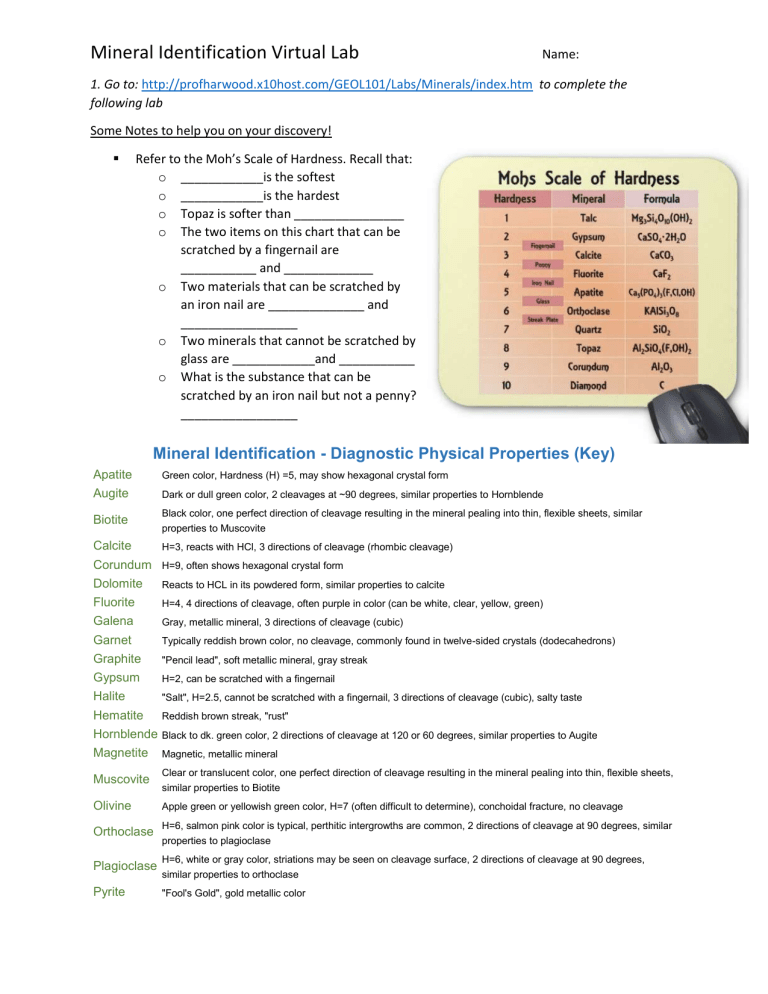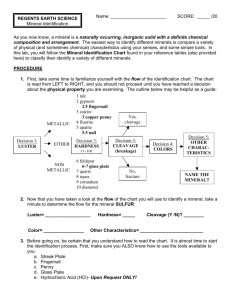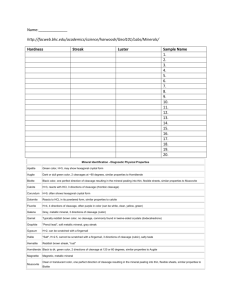
Mineral Identification Virtual Lab Name: 1. Go to: http://profharwood.x10host.com/GEOL101/Labs/Minerals/index.htm to complete the following lab Some Notes to help you on your discovery! Refer to the Moh’s Scale of Hardness. Recall that: o ____________is the softest o ____________is the hardest o Topaz is softer than ________________ o The two items on this chart that can be scratched by a fingernail are ___________ and _____________ o Two materials that can be scratched by an iron nail are ______________ and _________________ o Two minerals that cannot be scratched by glass are ____________and ___________ o What is the substance that can be scratched by an iron nail but not a penny? _________________ Mineral Identification - Diagnostic Physical Properties (Key) Apatite Green color, Hardness (H) =5, may show hexagonal crystal form Augite Dark or dull green color, 2 cleavages at ~90 degrees, similar properties to Hornblende Biotite Black color, one perfect direction of cleavage resulting in the mineral pealing into thin, flexible sheets, similar properties to Muscovite Calcite H=3, reacts with HCl, 3 directions of cleavage (rhombic cleavage) Corundum H=9, often shows hexagonal crystal form Dolomite Reacts to HCL in its powdered form, similar properties to calcite Fluorite H=4, 4 directions of cleavage, often purple in color (can be white, clear, yellow, green) Galena Gray, metallic mineral, 3 directions of cleavage (cubic) Garnet Typically reddish brown color, no cleavage, commonly found in twelve-sided crystals (dodecahedrons) Graphite "Pencil lead", soft metallic mineral, gray streak Gypsum H=2, can be scratched with a fingernail Halite "Salt", H=2.5, cannot be scratched with a fingernail, 3 directions of cleavage (cubic), salty taste Hematite Reddish brown streak, "rust" Hornblende Black to dk. green color, 2 directions of cleavage at 120 or 60 degrees, similar properties to Augite Magnetite Magnetic, metallic mineral Muscovite Clear or translucent color, one perfect direction of cleavage resulting in the mineral pealing into thin, flexible sheets, similar properties to Biotite Olivine Apple green or yellowish green color, H=7 (often difficult to determine), conchoidal fracture, no cleavage Orthoclase H=6, salmon pink color is typical, perthitic intergrowths are common, 2 directions of cleavage at 90 degrees, similar properties to plagioclase Plagioclase H=6, white or gray color, striations may be seen on cleavage surface, 2 directions of cleavage at 90 degrees, similar properties to orthoclase Pyrite "Fool's Gold", gold metallic color Quartz H=7, conchoidal fracture, no cleavage, color is typically white or clear but can be pink, red, purple, black Sulfur Yellow color, "rotten egg" smell if burned Talc H=1, very soft, easily scratched by fingernail Fill in the following table based on the “virtual tests” you run on each unknown mineral! SAMPLE COLOR STREAK CLEAVAGE CRYSTAL FORM FRACTURE HARDNESS LUSTER OTHER MINERAL NAME 1 White White None Not Present Irregular 2 Nonmetallic N/A Gypsum COLOR STREAK CLEAVAGE CRYSTAL FORM FRACTURE HARDNESS LUSTER OTHER MINERAL NAME 2 3 4 5 6 7 8 9 10 11 12 13 SAMPLE 14 15 16 17 18 19 20 2. Go to https://quizlet.com/105802093/chapter-2-minerals-flash-cards/?new. Note: this is a quizlet I made for you! Since it is specialized, it is likely going to be VERY helpful in studying for your test! a. Go to “Flashcards”: scroll through the flashcards (flipping them and quizzing yourself as you go!) b. Click on “Match”. Match the terms with their definitions. My time on my first attempt was ________________seconds My time on my second attempt was ______________seconds c. Click on “Test”. Set up your test to be “multiple choice and matching”. Make sure it is 25 questions. What was your score? ___________________ 3. Finally, look at the mineral samples provided. A)Draw (and color) three samples. B)Under your sketch, list 3 of the properties that you used to attempt to identify your mineral sample(s). C)Give it your best guess…what is the name of the mineral based on what you found?

